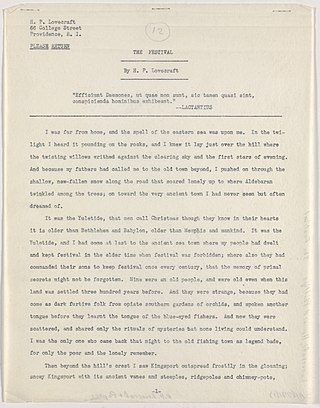Related Research Articles

Shub-Niggurath is a deity created by H. P. Lovecraft. She is often associated with the phrase "The Black Goat of the Woods with a Thousand Young". The only other name by which Lovecraft referred to her was "Lord of the Wood" in his story The Whisperer in Darkness.

Hastur is an entity of the Cthulhu Mythos.
Bran Mak Morn is a hero of five pulp fiction short stories by Robert E. Howard. In the stories, most of which were first published in Weird Tales, Bran is the last king of Howard's romanticized version of the tribal race of Picts.
Unaussprechliche Kulte is a fictional book of arcane literature in the Cthulhu Mythos. The book first appeared in Robert E. Howard's 1931 short stories "The Children of the Night" and "The Black Stone" as Nameless Cults. Like the Necronomicon, it was later mentioned in several stories by H. P. Lovecraft.
"Worms of the Earth" is a short story by American fantasy fiction writer Robert E. Howard. It was originally published in the magazine Weird Tales in November 1932, then again in 1975 in a collection of Howard's short stories, Worms of the Earth. The story features one of Howard's recurring protagonists, Bran Mak Morn, a legendary king of the Picts.

"Dagon" is a short story by American author H. P. Lovecraft. It was written in July 1917 and is one of the first stories that Lovecraft wrote as an adult. It was first published in the November 1919 edition of The Vagrant. Dagon was later published in Weird Tales in October 1923. It is considered by many to be one of Lovecraft's most forward-looking stories.

"The Festival" is a short story by H. P. Lovecraft written in October 1923 and published in the January 1925 issue of Weird Tales.

The Whisperer in Darkness is a 26,000-word novella by American writer H. P. Lovecraft. Written February–September 1930, it was first published in Weird Tales, August 1931. Similar to The Colour Out of Space (1927), it is a blend of horror and science fiction. Although it makes numerous references to the Cthulhu Mythos, the story is not a central part of the mythos, but reflects a shift in Lovecraft's writing at this time towards science fiction. The story also introduces the Mi-Go, an extraterrestrial race of fungoid creatures.

"The Rats in the Walls" is a short story by American author H. P. Lovecraft. Written in August–September 1923, it was first published in Weird Tales, March 1924.
"The Black Stone" is a horror short story by American writer Robert E. Howard, first published in the November 1931 issue of Weird Tales. The story introduces the character of Justin Geoffrey, a mad poet, and the fictitious book Unaussprechlichen Kulten by Friedrich von Junzt. The story is part of the Cthulhu Mythos, and follows the same pattern and has the same features as much of H. P. Lovecraft's classic work.

Many writers have been drawn to the idea of the Picts and created fictional stories and mythology about them in the absence of much real data. This romanticised view tends to portray them as sometimes wearing the modern kilt or as noble savages, much as the view of Europeans on Native Americans in the 18th century.

"Medusa's Coil" is a short story by H. P. Lovecraft and Zealia Bishop. It was first published in Weird Tales magazine in January 1939, two years after Lovecraft's death. The story concerns the son of an American plantation owner who brings back from Paris a new wife. It mixes elements of Lovecraft's Cthulhu Mythos with the ancient Greek myth of Medusa, but it has also been noted for its racist aspects.
Professor John Kirowan is a fictional character from Robert E. Howard's contributions to H.P. Lovecraft's story cycle "the Cthulhu Mythos".
"The Haunter of the Ring" is a 1934 short story by American writer Robert E. Howard, belonging to the Cthulhu Mythos. It was first published in the pulp magazine Weird Tales in the June 1934 issue. Howard earned $60 for this publication. This story is set in the modern age but includes a relic from the Hyborian Age of the Conan the Barbarian stories, the ring of Thoth-Amon.
A list of prose works by Robert E. Howard. The works are sorted by genre, by series and then alphabetically. Untitled works and fragments are listed separately by their opening line.
Serpent Men are a fictional race created by Robert E. Howard for his King Kull tales. They first appeared in "The Shadow Kingdom", published in Weird Tales in August 1929.

Nameless Cults: The Cthulhu Mythos Fiction of Robert E. Howard is a collection of Cthulhu Mythos short stories by Robert E. Howard. It was first published in the US in 2001 by Chaosium Press. All of these stories had been published previously, between 1929 and 1985, in Weird Tales, From Beyond the Dark Gateway, Strange Tales, Weirdbook, Fantasy Crosswinds, Coven, Fantasy Book, Dark Things, and The Fantasy Magazine.
"Men of the Shadows" is the title of a poem by American writer Robert E. Howard, published sometimes in itself and sometimes at the beginning of a 1926 story with the same title, dealing with the Pictish King Bran Mak Morn. The poem was first published in 1957 in Always Comes Evening, a collection of Howard poems.
References
- ↑ Works of Robert E. Howard, retrieved 16 August 2007
- ↑ REHupa Archived 2007-12-29 at the Wayback Machine , retrieved 20 August 2007
- ↑ de Camp, L. Sprague; de Camp, Catherine Crook; Griffin, Jane Whittington (2011). Dark Valley Destiny: the Life of Robert E. Howard. Orion Publishing Group. p. 260. ISBN 9780575103627.